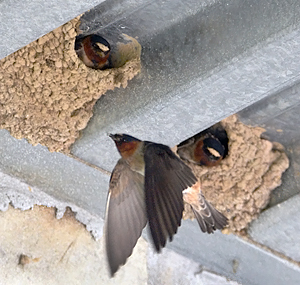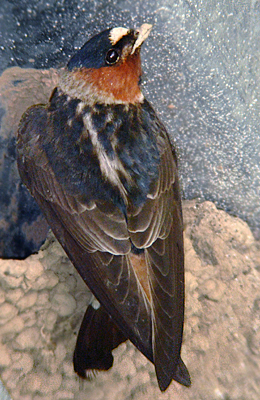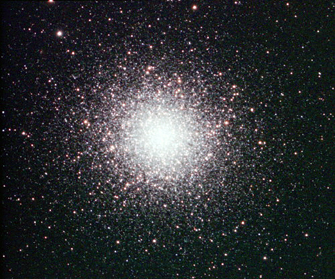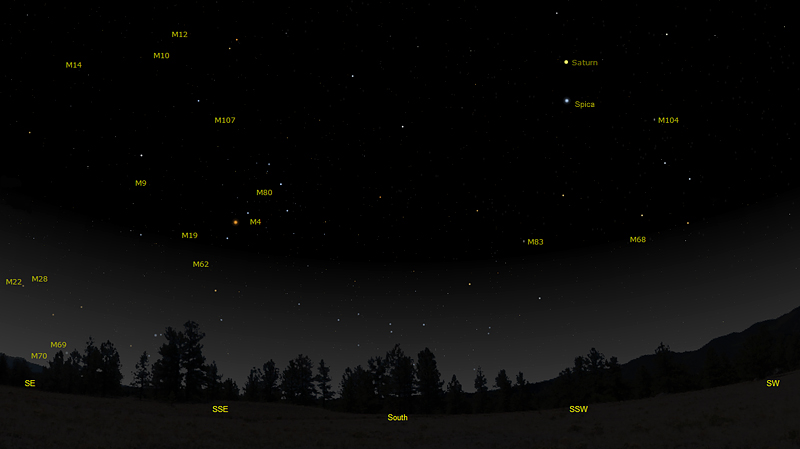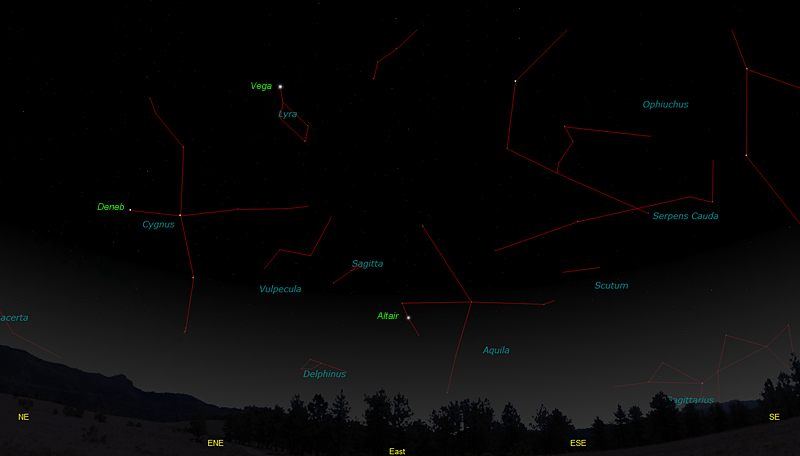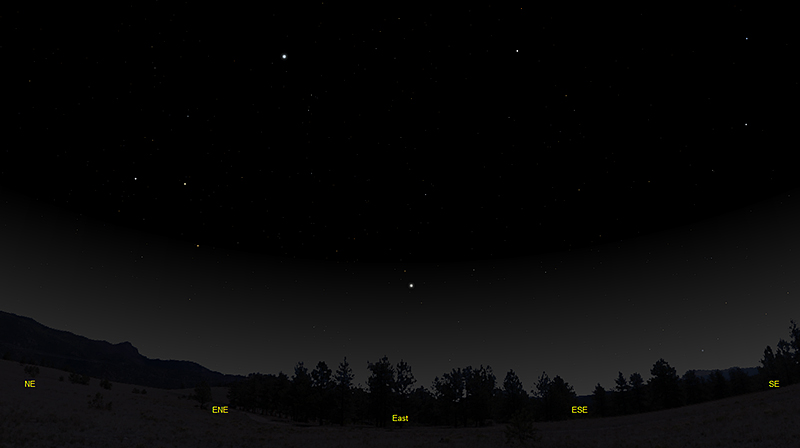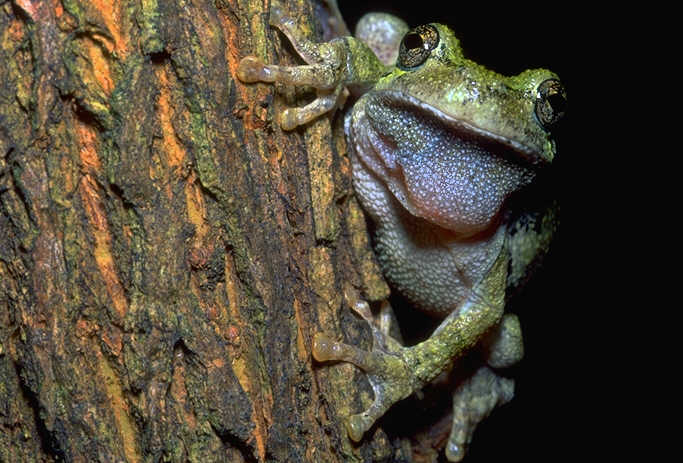The purpose of this feature is to give scout leaders, educators and naturalists an idea of some of the natural events coming up each month. We will try to cover a variety of natural events ranging from sky events to calling periods of amphibians, bird and mammal watching tips, prominent wildflowers and anything else that comes to mind. We will also note prominent constellations appearing over the eastern horizon at mid-evening each month for our area for those who would like to learn the constellations. If you have suggestions for other types of natural information you would like to see added to this calendar, let us know! Note: You can click on the hyperlinks to learn more about some of the featured items. To return to the Calendar, hit the "back" button on your browser, NOT the "back" button on the web page. All charts are available in a "printer friendly" mode, with black stars on a white background. Left clicking on each chart will take you to a printable black and white image. Please note that images on these pages are meant to be displayed at 100%. If your browser zooms into a higher magnification than that, the images may lose quality. Though we link book references to nationwide sources, we encourage you to support your local book store whenever possible. Notes and Images From May 2012
In February of 2011, on a particularly cold and gray winter day, I wrote about jogging beneath an interstate bridge that had Cliff Swallow nests from the previous summer. The nests seemed to hold the promise of the swallows' return and the coming spring.
But the swallows did not
return that year. I waited in vain through late March and April
without seeing the familiar dark forms zipping in and out of the mud
nests.
In reading about Cliff Swallows I found that it is not uncommon for nesting colonies to relocate from year to year. According to Chapman (1973) alternate site usage patterns may have evolved as a response to the increase in nest parasites during the breeding season. Allowing a former breeding site to go unoccupied for a season or two reduces the populations of these parasites. Breeding colonies do appear to be loyal to a general area, and select their breeding sites from that area. Nesting sites were originally natural features such as cliffs and bluffs, but in modern times also include bridges like my bridge, dams, and the eaves of houses, barns and other dwellings. Cliff Swallows are long distance migrants, wintering in Brazil, Paraguay, Argentina and Chile. Unlike many migrants, they migrate during the day, feeding as they go. Their diet consists mainly of small insects caught on the wing. Chapman, B.R., 1973, The effects of nest ectoparasites on Cliff Swallow populations, 1973, Unpublished Ph.D. dissertation, Lubbock, Texas, Texas Tech Univ.
Sky Events for June 2012: The Sun is at the Summer Solstice at 6:09pm CDT on June 20th, marking the beginning of summer in the Northern Hemisphere, and the longest day of the year. Due to a number of factors the earliest sunrise occurs about 2 weeks before the solstice and the latest sunset occurs about two weeks after the solstice. On June 5th, Venus transits the face of the Sun. This is a rare and historic occurrence. Though the last transit of Venus took place in 2004, the next transit will not take place until the year 2117. Here in Tennessee, we will see only the beginning of the transit, as the Sun will set before Venus finishes its journey. Important - do not attempt to view this eclipse without adult supervision and without proper solar filters installed on your telescope. Permanent and severe eye damage, including blindness, can occur instantaneously if proper filters are not used. Cap your finder telescope and do not use it to aim the main telescope. Instead, look at the shadow of the tube and adjust the position of the telescope to make the shadow look round. Then look through the filtered scope. Probably the safest way to view the transit through small telescopes is to use a solar projection screen as we mentioned in last month's Natural Calendar. Information about the required parts can be seen here (though you'll need to hustle to get the projection film in time). Venus will begin to cross the solar disk around 5:05pm CDT, when the Sun is about 32 degrees above the western horizon. The Sun will set around 8:00pm CDT, with Venus less than halfway through its transit. It will appear as a rather small black dot against the face of the Sun. If you cannot wrangle a telescope and filters or if you are clouded out on the day of the transit, there are online sites at which you can view the transit live. Here the internet excels. Want to view live from the top of Mauna Loa in Hawaii? No problem. How about Israel, Australia, Norway or the American southwest? All it takes is an internet connection and a few mouse clicks. You may want to visit a few sites in advance and play their test videos to make sure your flash player is operating as it should. Sure, it's not as good as seeing the transit with your own telescope, but it's a close second. Links for all of the above sites can be found here on Discover Magazine's web site, under "How to Watch the Transit Online." More online sites can be found at Sky and Telescope's site here.
Evening Sky: As June begins, Saturn is due south about 47 degrees above the horizon at dusk. The bright star Spica, in Virgo, is about 5 degrees below Saturn and almost as bright. The two objects form a striking visual pair. This is a great time to see Saturn, and just about any small telescope will give a great view. Mars, in Leo, continues to fade as the Earth pulls away from it. Look for it about 15 degrees southeast of the bright star Regulus. Mercury is visible at dusk from about mid-June through the end of the month. Look for it especially during the last week of the month, when it will set about 1-1/2 hours after the Sun. Begin looking for it about 30 to 40 minutes after sunset wherever you can find a flat western horizon. Binoculars will help you spot it, but wait till the Sun has set to begin sweeping for it.
Summer Evening Globular Clusters: This time of year is a great time to begin exploring the great globular clusters surrounding our Milky Way Galaxy. These spherical clusters of stars can measure over 100 light-years in diameter, and inhabit the halo around our galaxy. Distances are in the 10's of thousands of light-years. In large telescopes they can be quite beautiful. In smaller telescopes you can usually resolve at least the outer stars in the cluster. Robert Burnham wrote in Burnham's Celestial Handbook about seeing the globular cluster Messier 5 in the Naval Observatory Station's 40 inch reflector at Flagstaff, Arizona:
We enjoy picking out the some of the globular clusters of summer with binoculars or a small telescope on clear summer nights. Below is a chart that shows the view looking south at 10:00pm on June 15th. If you have a dark sky away from city lights, you might try finding some of the objects shown. Most will look like small faint patches of light. You can use Saturn and the bright star Spica just below it to get oriented. Shown are the positions for some of the globular clusters visible, as well as the galaxies Messier 83 and Messier 104. Of the globulars, M4, M10, M12 and M22 are some of the brighter ones. Clicking on the chart will bring up a printable black stars on white background chart that you can print. Morning Sky: Jupiter rises only about 45 minutes before the Sun on the first of the month, but will gradually make it's way higher into the dawn sky. Around the middle of the month, it will be joined by Venus, which has completed its solar transit and is now in the morning sky. Look for it below and to the left of Jupiter. All times noted in the Sky Events are for Franklin, Tennessee and are Central Daylight Time. These times should be pretty close anywhere in the mid-state area. Constellations: The views below show the sky looking east at 10:00pm CDT on June 15th. The first view shows the sky with the constellation outlined and names depicted. Star and planet names are in green. Constellation names are in blue. The second view shows the same scene without labels. New constellations this month in the eastern sky are Lyra, the Lyre, with it's bright star Vega, Cygnus, the Swan, and Aquila, the Eagle. The bright stars Vega, Deneb and Altair form the "summer triangle."
On Learning the Constellations: We advise learning a few constellations each month, and then following them through the seasons. Once you associate a particular constellation coming over the eastern horizon at a certain time of year, you may start thinking about it like an old friend, looking forward to its arrival each season. The stars in the evening scene above, for instance, will always be in the same place relative to the horizon at the same time and date each June. Of course, the planets do move slowly through the constellations, but with practice you will learn to identify them from their appearance. In particular, learn the brightest stars (like Altair and Vega in the above scene looking east), for they will guide you to the fainter stars. Once you can locate the more prominent constellations, you can "branch out" to other constellations around them. It may take you a little while to get a sense of scale, to translate what you see on the computer screen or what you see on the page of a book to what you see in the sky. Look for patterns, like the stars that make up the constellation Lyra. The earth's rotation causes the constellations to appear to move across the sky just as the sun and the moon appear to do. If you go outside earlier than the time shown on the charts, the constellations will be lower to the eastern horizon. If you observe later, they will have climbed higher. As each season progresses, the earth's motion around the sun causes the constellations to appear a little farther towards the west each night for any given time of night. If you want to see where the constellations in the above figures will be on July 15th at 10:00pm CDT, you can stay up till 12:00am CDT on June 15th and get a preview. The westward motion of the constellations is equivalent to two hours per month. Recommended: Sky & Telescope's Pocket Star Atlas is beautiful, compact star atlas. It is destined to become a classic, and is a joy to use at the telescope. A good book to learn the constellations is Patterns in the Sky, by Hewitt-White. You may also want to check out at H. A. Rey's classic, The Stars, A New Way to See Them. For skywatching tips, an inexpensive good guide is Secrets of Stargazing, by Becky Ramotowski. A good general reference book on astronomy is the Peterson
Field Guide,
A Field Guide to the Stars and Planets, by Pasachoff. The book retails for around $14.00. Starry Night has several software programs for learning the night sky. Visit the Starry Night web site at www.starrynight.com for details.
Amphibians:
In June the treefrogs really hit their stride. Listen for Cope's Gray Treefrogs, Gray Treefrogs, Bird-Voiced Treefrogs, Green Treefrogs and Barking Treefrogs. Northern Cricket Frogs and Southern Cricket Frogs call a lot during June, and the calls of Bullfrogs, Green Frogs and Fowler's Toads fill the night air. After heavy rains listen for the high, insect-like call of the Eastern Narrowmouth Toad and the strange-sounding Eastern Spadefoot. Recommended: The Frogs and Toads of North America, Lang Elliott, Houghton Mifflin Co.
Birds: Now is a good time to get to know the breeding birds of Tennessee. It's fun to take a trip to the Great Smoky Mountains National Park in June and hike a high altitude trail, like the Alum Cave Bluff trail. By doing so you can encounter birds that breed in Tennessee at these higher elevations, like Black-throated Blue Warblers, Canada Warblers, Chestnut-sided Warblers and Blackburnian Warblers. Recommended: The Sibley Guide to Birds, David Allen Sibley The Sibley Guide to Birds of Eastern North America, David Allen Sibley An inexpensive guide for beginners is the Golden Guide for Birds.
Archives (Remember to use the back button on your browser, NOT the back button on the web page!) Natural Calendar February 2012 Natural Calendar December 2011 Natural Calendar November 2011 Natural Calendar September 2011 Natural Calendar February 2011 Natural Calendar December 2010 Natural Calendar November 2010 Natural Calendar September 2010 Natural Calendar February 2010 Natural Calendar December 2009 Natural Calendar November 2009 Natural Calendar September 2009 Natural Calendar February 2009 Natural Calendar December 2008 Natural Calendar November 2008 Natural Calendar September 2008 Natural Calendar February 2008 Natural Calendar December 2007 Natural Calendar November 2007 Natural Calendar September 2007 Natural Calendar February 2007 Natural Calendar December 2006 Natural Calendar November 2006 Natural Calendar September 2006 Natural Calendar February 2006
Natural Calendar
December 2005
Natural Calendar
November 2005
Natural Calendar
September 2005
Natural Calendar
February 2005
Natural Calendar
December 2004
Natural Calendar
November 2004
Natural Calendar
September 2004
Natural Calendar
February 2004
Natural Calendar
December 2003
Natural Calendar
November 2003
Natural Calendar
September 2003 Natural Calendar February 2003 Natural Calendar December 2002 Natural Calendar November 2002 Nature Notes Archives: Nature Notes was a page we published in 2001 and 2002 containing our observations about everything from the northern lights display of November 2001 to frog and salamander egg masses. Night scenes prepared with The Sky 6 Professional from Software Bisque All images and recordings © 2011 Leaps |
||||||||||
